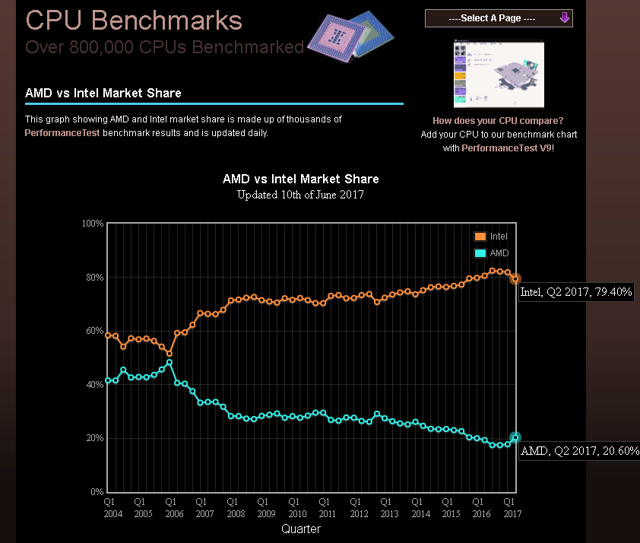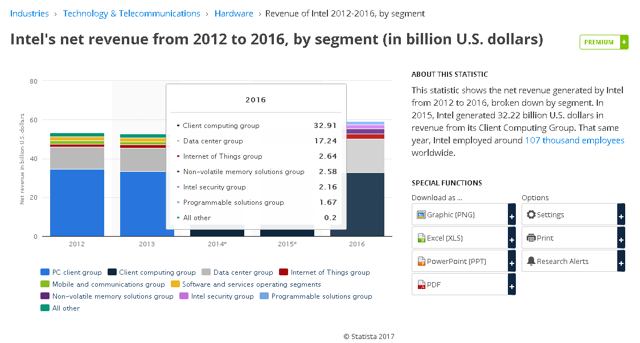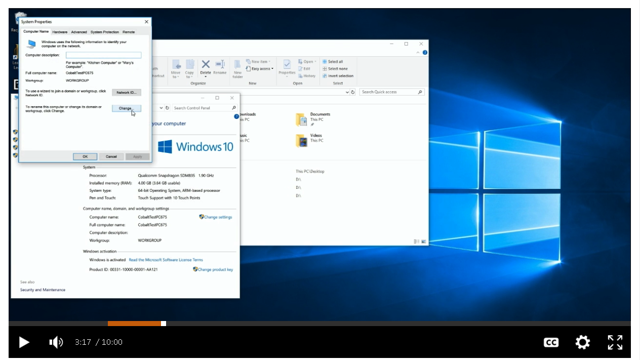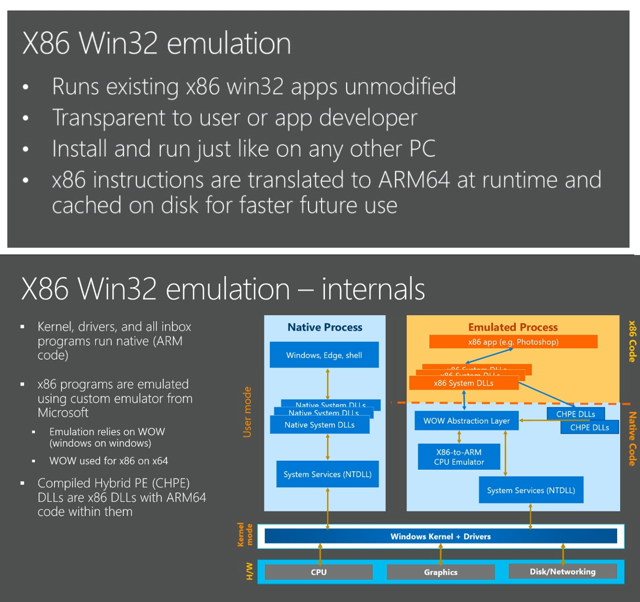Intel (NASDAQ:INTC) has almost 80% share of the global market for x86 desktop computer processors. I'm therefore not surprised Intel issued a veiled threat against companies emulating x86-based Win32 software on non-x86 processor-equipped Windows 10 computers. Intel has no smartphone application processor business, sales of x86 desktop/laptop computer processors is therefore the biggest contributor to Intel's Client Computing Group business segment. Consequently, the Client Computing Group is Intel's largest revenue generator.

(Source: cpubenchmark.net)
The Client Computing Group's 2016 revenue was $32.91 billion. Its Q1 2017 revenue was $8 billion. Intel has serious financial incentives to quickly extinguish any emerging threat to its x86 PC processor business. An ARM-based processor inside Windows 10 desktop/laptop computers is definitely a threat.

(Source: Statista)
Going forward, no margins-pressured PC manufacturer is going to accept an Intel Core i5 for $240 if there is a $50-$100 Snapdragon ARM processor/modem/GPU, which could to the same job of running Windows 10 and Win32 apps.
Warning Those Who Want To Erode Intel's PC Processor Sales
Microsoft (NASDAQ:MSFT) and Qualcomm (NASDAQ:QCOM) are the only firms I know which are working on a software emulation of x86 Win32 apps using a Snapdragon 835 processor. Intel's blog post detailed it has 1,600 patents on x86 processor and related technologies. Microsoft's software emulator layer could be trampling on some of those Intellectual Properties which Intel owns.
Intel said it is going to take legal action against any firm that it perceives as a violator of its x86 ISA [Instruction Set Architecture] and related patents. I am not a lawyer and I'm not a programmer. I only know that Intel will fight tooth and nail to protect its x86 processor business. Selling desktop/laptop processors is Intel's core strength since the 1970s.
It is already bad that its Wintel partner, Microsoft, is the main instigator of the Windows 10-on-ARM-processor campaign. After a $7.6 billion write-off of its Windows 10 Mobile Snapdragon-equipped Lumia phones business, Microsoft's next grand scheme is to popularize always-on, always-connected cellular PCs with Snapdragon processors.
I'm amused by Microsoft's cellular PC concept. I'm a graphic artist. Based on my years of experience with software emulation (VirtualBox, VMWare, BlueStacks, WINE on Linux), I do not see any major benefit from using an ARM-based Windows PC. Software-emulated Photoshop CC 2017 on Snapdragon 835 will still be slower than using an Intel Core i5-equipped PC. However, Intel's OEM partners (and top PC vendors) HP (NYSE:HPQ), Lenovo (OTCPK:LNVGY), and ASUSTeK (OTC:ASUUY) have enlisted to produce Snapdragon-equipped Windows 10 computers. Their support means they see a potential market for cellular PCs.
Why Microsoft Had To Implement Software Emulation Of Win32 Apps
The geniuses at Microsoft and Qualcomm finally managed to install and run the full version of 64-bit Windows 10 running on Snapdragon 835. However, Microsoft's act of implementing software emulation of x86 Win32 apps was necessary to make the cellular PC acceptable to people. 
(Source: Microsoft)
Adobe (NASDAQ:ADBE), Intuit (NASDAQ:INTU) and Autodesk (NASDAQ:ADSK) are just some of the x86 Win32 software developers that refused to build UWP-compliant (Universal Windows Platform) versions of their industry-standard products. You can go check the Windows 10 app store, no UWP versions are available for Adobe Creative Cloud software suite or AutoCAD family of products. There is also no UWP version of desktop Office 2016 or Office 2013.
Microsoft already has its free Project Centennial tool that allows software developers to port x86 Win32 apps to UWP format. But many developers are ignoring it. Microsoft therefore decided to create its own software emulator to run any x86 Win32 (no support yet for native Win64) apps on Windows-on-ARM computers.
The cellular PC product is going to die quickly if it cannot be used for industry-standard (but not UWP-compliant) software like Photoshop, QuickBooks, and AutoCAD. Millions of custom, proprietary enterprise/corporate software programs were also created on x86 Win32 instruction set. Software emulation of x86 programs is therefore the only way Microsoft could make the cellular PC acceptable to enterprise users.
Microsoft's software emulation layer is automatic. All emulated x86 win32 apps will reportedly run on ARM64 devices with near-native speed. It will be up to Intel's best patent lawyers to figure out if Microsoft's implementation of x86 to ARM64 software emulation violated any of Intel's 1,600 patents.

(Source: Microsoft)
Microsoft's software emulation of Win32 apps on ARM64 devices is like opening the floodgates which could drown Intel's annual 10-figure PC processor sales.
Final Thoughts
Asus, HP, and Lenovo probably got satisfied with the decent multi-tasking performance of software-emulated x86 Win32 apps on Snapdragon-powered Windows 10 computers. The future danger to Intel is, instead of these PC manufacturers exclusively buying x86 Kaby Lake or Skylake Core i-Series processors, they will also be sourcing out Snapdragon processors from Qualcomm.
Suing (based on any patent infringement its lawyers could come up with it) is probably the only way Intel could stop Microsoft's Snapdragon-based cellular PC campaign. If Intel indeed has the patents to prevent implementation of software emulation of x86 Win32 apps, it will do so.
No offer of licensing fees from Qualcomm/Microsoft will sway Intel. Intel knows that giving such permission will allow ARM-based processors to quickly erode its lucrative PC processor business. ARM-based processors already won in mobile devices. It will be catastrophic if Intel also allows ARM-based processors to proliferate inside Windows desktop/laptop computers.
Going forward, Qualcomm won't be the only one that's going to make Windows 10-friendly ARM processors. Apple (NASDAQ:AAPL), Samsung (OTC:SSNLF), Nvidia (NASDAQ:NVDA), MediaTek, even Advanced Micro Devices (NASDAQ:AMD) have the license to create ARM-based processors. Instead of Intel competing only with money-losing AMD for desktop/laptop processors, there will be several cash-rich rivals to contend with.
I do not think Intel can hold on to its 79.4% share in PC processors once ARM-based processors get inside Apple, HP, Dell, or Lenovo-branded laptops/desktop computers. Sales of Intel PC modems will also seriously suffer from Snapdragon-equipped cellular PCs.
My recommendation now is for Mr. Krzanich to call Mr. Nadella and offer him an energy-efficient, LTE modem-equipped 10-nanometer x86 processor. Nadella will likely accept if it can compete with the Snapdragon 865.
It is likely more expensive than ARM-based chips, but an LTE-equipped x86 processor is still the best CPU for Microsoft's cellular PC or Surface phone. An x86 Surface phone or Surface laptop doesn't need software emulation to run Win32 apps.
I'm long INTC and MSFT. I would hate to see these two facing each other in a patent-related courtroom drama. Intel could have prevented this emerging legal war if it did not stop development of its LTE-SoFIA Atom processor. In my view, Microsoft only wanted a processor that can run full Windows 10/win32 apps on PC and mobile devices.
Microsoft's involvement with Snapdragon-powered cellular PCs is a desperate move to fulfill its mission of 1 billion devices running Windows 10 by 2018. It is already the middle of 2017. Windows 10 is only running on 500 million devices.
Disclosure: I am/we are long MSFT, INTC, AAPL, NVD.
I wrote this article myself, and it expresses my own opinions. I am not receiving compensation for it (other than from Seeking Alpha). I have no business relationship with any company whose stock is mentioned in this article.
Source: Why Intel Wants To Stop Microsoft's Emulation Of X86 Win32 Apps On Snapdragon 835
No comments:
Post a Comment